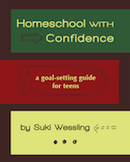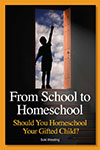It was one of those days.
We were in the midst of a thoroughly normal, peaceful morning. My husband had dropped our son at the bus stop, our daughter had eaten a great breakfast, and we seemed poised for a lovely homeschooling day.
Then came the topknot. I can’t really explain to you, except that sometimes when things go wrong for my daughter, they go really wrong. She wanted me to do a “topknot” in her hair, but apparently I didn’t do it right, so she decided to do it herself. The problem is, she does hair just about as well as you’d expect six-year-old fingers to do.
But in her brain she saw perfection. As she worked harder and harder to realize her desires, she got more and more frustrated.
I have learned to leave her to her own devices in this situation. Generally she gets angry, then she finds some way to give in to imperfection and goes on with her day as if nothing had happened. But today she got more and more frustrated, more and more angry. I went back to try to help her but she was too furious to deal with me.
It was one of those homeschooling days where I was just going to have to give up. She finally calmed herself and listened to stories on Tumblebooks for much of the morning. Then we went and spent a Gayle’s gift card we had had hanging around, and then used a Cost Plus coupon that was going to expire. Then we went to the beach and she sang and made a sand castle. We found two heart-shaped rocks. Art class, pick up brother from the bus, and the day was over before it began. I had very little to show for our homeschooling day. What had we learned?
Cut to dinnertime. Her daddy was talking about something that would take four days. “That would be about a hundred hours,” she said. I asked her how many exactly. “Ninety-six,” she said, not missing a beat.
She’s six. She spent her morning listening to picture books, though she can read chapter books. She would go nuts trying to finish one page of her first grade math book, yet she can compute 24×4 by working backwards from 25×4.
It’s hard to know what to do with a kid like this. Everyone tells me not to worry, but it’s hard to know how to plan a day, much less plan a lesson. I’m so envious of other homeschooling moms who know what their children need to learn next. I don’t even know what my child knows, much less what she needs to learn.
As the day progressed, she came up with ideas for the next subject we should study. Microbiology, she said. Knights and castles. All of this is equally possible and impossible. Possible because in this wonderful networked world we live in, we don’t even have to go to the library to pursue our fancies. I just typed “knights” in the searchbox on Cosmeo.com and came up with a story about knights doing fractions. She’ll love it.
Whether or not she could do fractions on a page, and sit still long enough to fill in bubbles on a standardized test, I don’t know.
Asynchronous development is the fancy word for what’s going on. She’s a six-year-old who has an hourlong meltdown about a hairdo. She’s a six-year-old who can do fourth-grade math in her head. She is perfectly happy sitting alone on a beach digging sand and watching water fill up the hole. She can read anything she wants, yet chooses to read preschool picture books. Her favorite place in the library is at the board books.
Inexplicable things cause her to fritz out. “Why did she do that?” another parent or teacher will ask. If I knew, I’d deserve a Nobel Prize for cracking the mystery of the human brain. No one can tell you why some children’s brains just don’t go the way that other kids’ brains do. But lots of people can tell you that it usually works out OK.
Asynchronous development doesn’t mean non-development. Her emotions, her ability to handle transitions and frustrations, her interactions with other kids — all that is developing…slowly.
Her ability to do math in her head, her reading comprehension, her quick and exact ability to sum up the meaning of an event — all this is running full steam ahead. Sometimes it slows down and the child grows into an adult who is relatively in balance. Sometimes…
We won’t worry about that. We’ll think about knights and microbiology and Tai Kwon Do. It’s all we can do.


